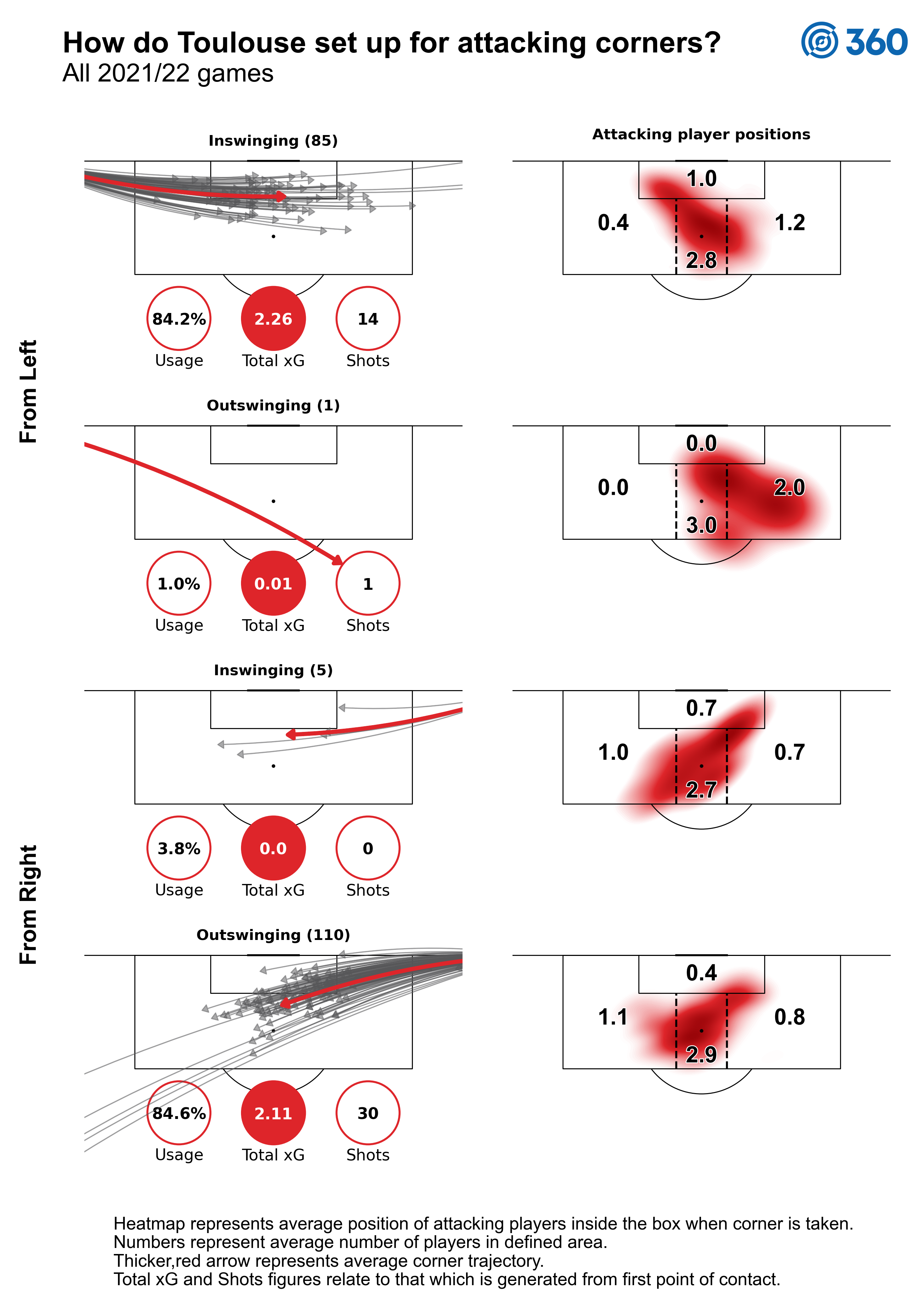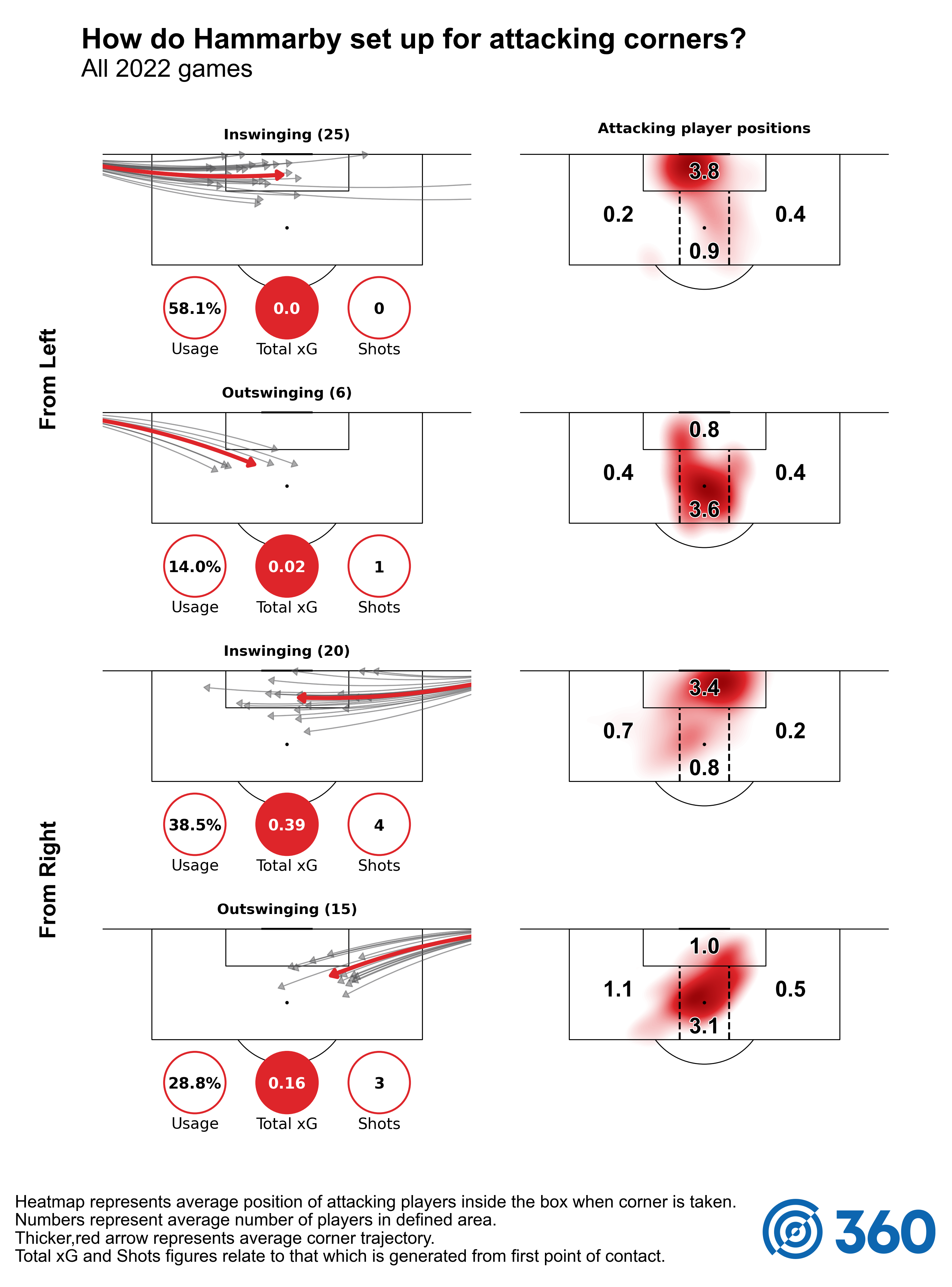Like the use of data, the amount of time and resources given to coaching set-pieces continues to increase with every season. There was a time when set-piece goals were once almost seen to count for less than a goal scored at the end of a 20-pass sequence, but in the present day, the two best teams in the Premier League last season – two of the most resourced teams in the world - were also the two teams that scored the most set-piece goals.
We’re now at a stage where teams that don’t dedicate adequate resources to set plays are actively choosing to leave an edge on the table, and increasingly we’re seeing clubs advertising for set-piece analysts and coaching roles. At StatsBomb, we only want to help football clubs become more successful. And we know that the most effective set-piece analysts will be those who can use data and video as part of a streamlined analysis process.
Using StatsBomb 360 data, which contains the location of every player in the frame around every event we collect, we’re able to drill down into set-pieces more efficiently and identify trends before we get to the video. To demonstrate, we’re going to look at four of the best set-piece teams in Europe and see what we can learn about them.
First, we head to France.
Toulouse FC
Toulouse secured promotion back to Ligue 1 at the second attempt following their relegation in 2020. The club have been public with their desire to become data-driven and maximise every available edge to be successful, including exploiting set plays, proving again that you don’t need to be a top-tier club to invest and succeed with this approach.
As well as having the most aggressive press in the league, the best open play attack, and the 2nd-best open play defence, Toulouse were also the best team in Ligue 2 from set-pieces in 2021/22, particularly from corners. Les Pitchouns generated 11.4 xG from corners, far more than the next-best, Dijon (7.0), and more than double the league average (5.5).

Clearly, this is a phase of the game they have taken the time to improve, as President Damien Comolli has alluded to recently, so let's look at what Toulouse were doing on corners and see what we can learn. This is where 360 data can really tell a story.

What can we learn from this?
- They favoured inswinging corners from the left and outswinging corners from the right. Right-footed midfielder Branco van den Boomen and his elite deliveries probably influenced this choice
- Their inswinging corners from the left generated fewer shots (14 from 85 corners) than their corners from the right, but a higher xG/shot (2.3 xG from 14 shots)
- The deliveries from the left were generally aimed in the near post/central area about six yards out
- However, they didn’t often have players starting in those positions, with many positioned in the centre of the box or towards to far post to make attacking runs to those areas
- Their outswinging corners from the right generated more shots (30 from 110 corners) but generated a lower xG/shot (2.1 xG from 30 shots)
- The deliveries were again generally aimed at the near post/central area around six yards out
- They did not often position players around the keeper for these corners, averaging just 0.4 players in the six-yard box on these plays
Using only data, we’ve learned: what type of delivery they’re likely to make, their approach depending on which corner, where the delivery is likely to be aimed, and where the players are likely to position themselves before the play.
However, we can still dig deeper to extract more information about their approach.
Looking at their 10-game trendlines for Shots From Corners and Corner xG through the 2021/22 season, we can observe that they perhaps struggled (relatively) in the first and third quarters of the season and had their best spells in the second and fourth quarters.

Let’s compare their corners from the first ten games and the last ten games of the season to see if we can extract any trends.

- They took nearly twice as many corners in the last ten games as in their first ten games. But is this the reason for the uptick? Not quite. They created 20 shots from 67 corners (30%) in the last ten, compared to 5/36 (14%) in the first ten. Their xG per Corner tripled from 0.01 to 0.03.
- They aimed their inswinging deliveries from the left at similar areas, but there was more emphasis on loading players in the centre of the box
- Likewise, their outswinging delivery profiles were broadly consistent across both samples, but the concentration of players in central areas increased
- It’s notable that they stopped positioning players in the six-yard box as often during the last ten games
The data suggests that Toulouse refined and tweaked their approach in the run-in to push their title victory over the line.
It’s also important to consider which players to be aware of when analysing a team’s set-play strategies. Within seconds we can find out that Danish centre-back Rasmus Nicolaisen was Toulouse’s most dangerous aerial threat in the opposition box, winning 20/30 of his aerial duels in the penalty area.

Video analysis will always be the most crucial aspect of set-piece analysis. But, we can save *massive* amounts of time with data AND provide essential contextual information that’s needed when presenting to coaching staff. We’ve quickly identified some key trends, but we also now know the specific questions we’d seek to answer when conducting the video analysis.
Let’s do a quickfire tour through the rest of Europe now.
Strømsgodset IF
With the Eliteserien season at the midway point, 6th-placed Strømsgodset are currently on course for their best finish in five seasons. Part of this is down to their success from corners: they’re currently the league leaders for corner xG and corner shots.

Their set-pieces are keeping them from relegation trouble, with their metrics in open play less impressive. Let’s see what they’ve been doing so far in 2022.

- Like Toulouse, they favour inswinging corners from the left and outswinging corners from the right – holding midfielder Herman Stengel being the primary set-piece taker
- Unlike Toulouse, Strømsgodset are much more intent on packing central areas, particularly in the six-yard box and around the goalkeeper – and even on outswinging corners
- This approach has been most fruitful on their inswinging corners, with a lot of deliveries put right into the central area six yards out and generating eight shots and 1.0 xG just from first contacts
- Centre back Gustav Valsvik (14/29) and forward Lars-Jørgen Salvesen (13/24) have been their most successful aerial duellists in the opposition area
Sparta Prague
Sparta managed 15 corner goals from 11.4 xG in 2021/22 as they finished 3rd in the Czech First League – the best in the league and a nearly identical record to Toulouse.
What were they doing that stands out?

- A preference for inswinging deliveries from the left. A mixed approach of inswinging and outswinging deliveries from the right
- Their inswinging deliveries on both sides had similar features. They had many players attacking the central and far post areas, and virtually no players featuring in the near-post zones
- Their outswinging corners saw them overload the centre of the penalty box
- 6’2” midfielder Ladislav Krejčí was the biggest threat, winning 19/27 aerial duels in the opposition box
- Bellows of “THIS. IS. SPARTAAAAAA” before every play*
*We reluctantly admit there is no evidence for this and it may be false.
Hammarby IF
Lastly, we stop off in the Allsvenskan to take a closer look at Hammarby. Their Corner xG of 0.35/game is currently the best record in the Allsvenskan, and they sit three points behind 1st with a game in hand in what’s shaping up to be an exciting title race.

- A more diverse set of deliveries, though there is clearly a preference for inswinging corners on both sides. They also utilise short corners more than any of the other sides we’ve looked at in this analysis
- Like Strømsgodset, Hammarby look to pack central areas: particularly the six-yard box on their inswinging corners
- As you’d expect from that, their inswinging deliveries tend to be put right on top of the goalkeeper
- Their outswinging deliveries tend to be aimed at the near-post
- However, they haven’t created too many shots from first contacts, suggesting something in their approach is creating more opportunities from second balls — a hypothesis to investigate further in video.
- We can also see they’ve had more success with their corners from the right side this season. Are they doing something different from that side, or is it simply that they’ve so far executed better on that side by pure chance?
Quickfire. Actionable. Information.
If the insight in this article is interesting to you, your club, media outlet, or organisation, don’t hesitate to get in touch today. We'll be back with more set-piece analysis next season.
